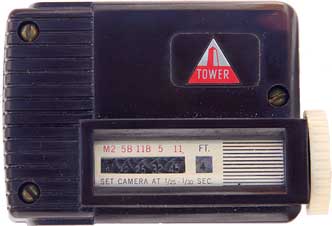
|
  Maker: Tower (Sears, Roebuck) Model: Flashometer Circa: 1955 Designer: Clarence Lee Folden Design Patent #: 180,014 Measure type: calculator only |
|
Tower is the house-brand of photo equipment for Sears & Roebuck. The equipment is identical to the famous-maker-brand versions, but you have to be able to recognize the maker's model to know who made it. I haven't see another of these so I don't know who the actual manufacturer was. C.L. Folden has a number of design patents, and two other photographic that he had (one for a camera and another for a flash attachment) were split 50/50 between Sears and G-M Labs. This seems like the sort of thing that G-M labs would have made as well. But they weren't assigned a share of the patent, so who knows. This is what the Norwood Flashrite should have been. The principle is the same: you have a rangefinder with a dedicated calculator which determines your exposure when using flash bulbs. The Flashright was complicated and intimidating; this is easy. There's a place to set your film speed (you pull out the knob and turn it until the proper speed shows up in the window. Then you look through the peep hole and turn the knob until the images come together. There's a window on top that tells you the distance in feet. To the left of the distance window, there's a row of ƒ/numbers, each one underneath a bulb type. So say you're shooting Kodachrome 25 at a distance of 8 feet and you're using a #5 bulb: you set the camera to 1/25th and the lens to ƒ/16. What if you realize you have M2 bulbs instead? Open up to ƒ/8. Obviously it's limited: you're stuck with 1/25th or 1/30th as your shutter sync, and you only the five bulbs that marked on the meter (M2, 5b, 11b, 5 and 11 respectively); the distance is between 4 and 20 feet, and the speeds go from ASA 10 to 80. But if you need greater flexibility, you buy the Flashrite. But I'm guessing for most people who had a little Argus C3 and shot birthdays and visiting relatives, this would get them through just fine. |
|
©opyright by James Ollinger. All Rights Reserved.
Company names and models are registered trademarks of their respective owners
and are not affiliated with this website in any way.
